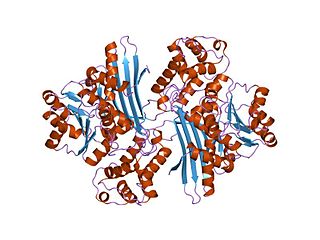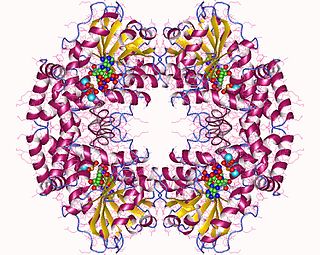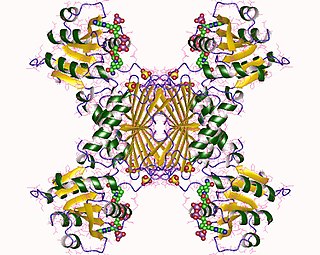
In molecular biology, the protein domain Saccharopine dehydrogenase (SDH), also named Saccharopine reductase, is an enzyme involved in the metabolism of the amino acid lysine, via an intermediate substance called saccharopine. The Saccharopine dehydrogenase enzyme can be classified under EC 1.5.1.7, EC 1.5.1.8, EC 1.5.1.9, and EC 1.5.1.10. It has an important function in lysine metabolism and catalyses a reaction in the alpha-Aminoadipic acid pathway. This pathway is unique to fungal organisms therefore, this molecule could be useful in the search for new antibiotics. This protein family also includes saccharopine dehydrogenase and homospermidine synthase. It is found in prokaryotes, eukaryotes and archaea.
In enzymology, a vomifoliol dehydrogenase (EC 1.1.1.221) is an enzyme that catalyzes the chemical reaction
In enzymology, a cholest-5-ene-3β,7α-diol 3β-dehydrogenase (EC 1.1.1.181) is an enzyme that catalyzes the chemical reaction

In enzymology, a homoisocitrate dehydrogenase (EC 1.1.1.87) is an enzyme that catalyzes the chemical reaction

In enzymology, a ketol-acid reductoisomerase (EC 1.1.1.86) is an enzyme that catalyzes the chemical reaction
In enzymology, an L-2-hydroxyglutarate dehydrogenase is an enzyme that catalyzes the chemical reaction
In enzymology, a 2-isopropylmalate synthase (EC 2.3.3.13) is an enzyme that catalyzes the chemical reaction

In molecular biology, hydroxymethylglutaryl-CoA synthase or HMG-CoA synthase EC 2.3.3.10 is an enzyme which catalyzes the reaction in which acetyl-CoA condenses with acetoacetyl-CoA to form 3-hydroxy-3-methylglutaryl-CoA (HMG-CoA). This reaction comprises the second step in the mevalonate-dependent isoprenoid biosynthesis pathway. HMG-CoA is an intermediate in both cholesterol synthesis and ketogenesis. This reaction is overactivated in patients with diabetes mellitus type 1 if left untreated, due to prolonged insulin deficiency and the exhaustion of substrates for gluconeogenesis and the TCA cycle, notably oxaloacetate. This results in shunting of excess acetyl-CoA into the ketone synthesis pathway via HMG-CoA, leading to the development of diabetic ketoacidosis.
2-Succinyl-6-hydroxy-2,4-cyclohexadiene-1-carboxylate synthase, also known as SHCHC synthase is encoded by the menH gene in Escherichia coli and functions in the synthesis of vitamin K. The specific step in the synthetic pathway that SHCHC synthase catalyzes is the conversion of 5-enolpyruvoyl-6-hydroxy-2-succinylcyclohex-3-ene-1-carboxylate to (1R,6R)-6-hydroxy-2-succinylcyclohexa-2,4-diene-1-carboxylate and pyruvate.
Momilactone-A synthase (EC 1.1.1.295, momilactone A synthase, OsMAS) is an enzyme with systematic name 3beta-hydroxy-9beta-pimara-7,15-diene-19,6beta-olide:NAD(P)+ oxidoreductase. This enzyme catalyses the following chemical reaction
Alpha-humulene 10-hydroxylase (EC 1.14.13.150, CYP71BA1) is an enzyme with systematic name alpha-humulene,NADPH:oxygen 10-oxidoreductase. This enzyme catalyses the following chemical reaction
Nitric-oxide synthase (NAD(P)H-dependent) (EC 1.14.14.47, nitric oxide synthetase, NO synthase) is an enzyme with systematic name L-arginine,NAD(P)H:oxygen oxidoreductase (nitric-oxide-forming). This enzyme catalyses the following chemical reaction
γ-Humulene synthase is an enzyme with systematic name (2E,6E)-farnesyl-diphosphate diphosphate-lyase (γ-humulene-forming). This enzyme catalyses the following chemical reaction
β-Eudesmol synthase (EC 4.2.3.68) is an enzyme with systematic name (2E,6E)-farnesyl-diphosphate diphosphate-lyase (β-eudesmol-forming). This enzyme catalyses the following chemical reaction
10-epi-γ-Eudesmol synthase (EC 4.2.3.84) is an enzyme with systematic name (2E,6E)-farnesyl-diphosphate diphosphate-lyase (10-epi-γ-eudesmol-forming). This enzyme catalyses the following chemical reaction:
α-Eudesmol synthase (EC 4.2.3.85) is an enzyme with systematic name (2E,6E)-farnesyl-diphosphate diphosphate-lyase (α-eudesmol-forming). This enzyme catalyses the following chemical reaction
α-Humulene synthase is an enzyme with systematic name (2E,6E)-farnesyl-diphosphate diphosphate-lyase (α-humulene-forming). This enzyme catalyses the following chemical reaction:

In enzymology, a 4-hydroxy-tetrahydrodipicolinate reductase (EC 1.17.1.8) is an enzyme that catalyzes the chemical reaction
In enzymology, a D-2-hydroxyglutarate dehydrogenase is an enzyme that catalyzes the chemical reaction
In enzymology, a prostaglandin-F synthase (PGFS; EC 1.1.1.188) is an enzyme that catalyzes the chemical reaction:





